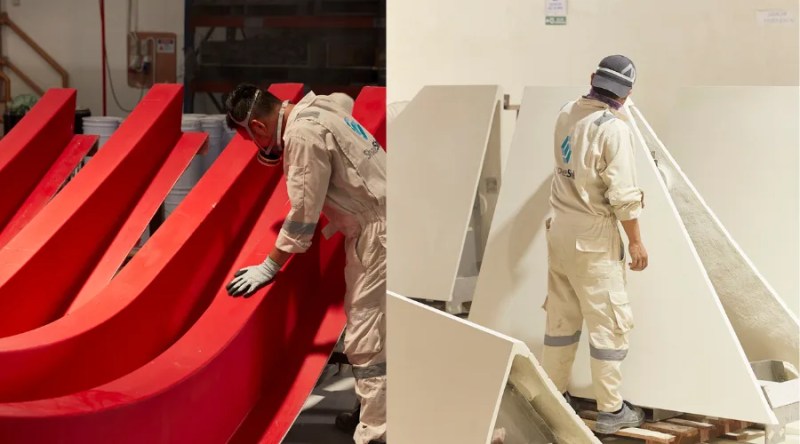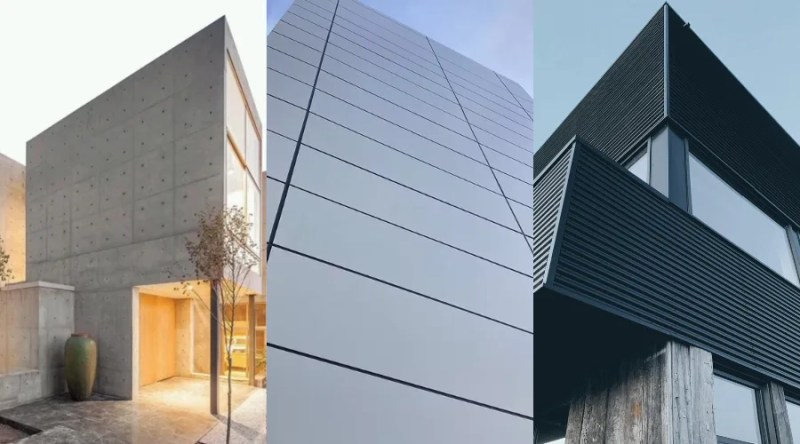The architecture and construction industries are under increasing pressure to reduce environmental impacts—not only during building operations, but across the full lifecycle of the materials used. As regulatory frameworks tighten and sustainability certifications become standard, attention is shifting toward the embodied emissions of construction materials: the total greenhouse gas emissions generated from raw material extraction through to manufacture, transport, installation, and eventual end-of-life treatment.
For architects and building consultants, the choice of materials is now a critical decision point in reducing project-wide carbon intensity. This shift places reinforced material systems like ShapeShell™—developed by ShapeShift Technologies—at the forefront of low-carbon design strategy. Offering lightweight, high-strength alternatives to traditional materials such as precast concrete, aluminium, and GFRC, ShapeShell™ enables ambitious design outcomes with significantly lower environmental burdens.

Defining Lifecycle Emissions
Lifecycle emissions, often referred to as embodied carbon or whole-of-life emissions, represent the total greenhouse gas emissions generated throughout the lifespan of a material or product—from raw material extraction to final disposal or reuse.
In the context of construction materials, lifecycle emissions are typically divided into several stages:
- Upstream (Cradle-to-Gate): Emissions from raw material extraction, processing, manufacturing, and transportation to site.
- Construction Phase: Emissions from installation processes, site waste, and temporary works.
- Use Phase (Operational Interface): Though materials like façades and internal linings may not emit carbon directly during use, they can influence energy performance, insulation, and durability, indirectly affecting a building’s operational footprint.
- End-of-Life: Emissions from demolition, transport to landfill or recycling, and associated waste processing.
Traditional materials such as aluminium, precast concrete, and steel typically have high embodied carbon due to energy-intensive production processes. For example, aluminium cladding systems carry heavy carbon loads from smelting and extrusion, while precast concrete contributes significantly through cement production—a known high-emissions activity.
Conversely, new-generation reinforced materials like ShapeShell™ have been engineered to minimise embodied carbon by:
- Using low-weight, high-strength fibre systems to reduce the quantity of material required,
- Incorporating recycled or repurposed inputs, such as glass aggregates or gypsum by-products,
- Offering high durability and minimal maintenance, extending service life and delaying replacement cycles.
By evaluating materials based on their lifecycle emissions profile—not just up-front cost or strength—design professionals can make more informed decisions that align with both performance and sustainability objectives.
ShapeShell™ Material Overview
ShapeShell™ is a suite of advanced fibre-reinforced materials engineered for architectural, infrastructure, and interior applications where performance, weight reduction, and environmental efficiency are critical. Each variant within the ShapeShell™ family has been developed to replace traditional heavy, high-emission materials without sacrificing durability, aesthetics, or design flexibility.
ShapeShell™ RT – Reinforced Thermoset
ShapeShell™ RT is a lightweight, fibre-reinforced thermoset panel system that combines glass, carbon, or aramid fibres within a polymer resin matrix. With flexural strengths exceeding 220 MPa and a weight as low as 5 kg/m², RT panels are suitable for façades, soffits, cladding, and free-form geometries. Manufactured using vacuum infusion and aerospace-grade techniques, RT panels provide:
- Corrosion, weather, and UV resistance
- Up to five times the strength of aluminium
- Low water absorption (<0.1%) and Class A fire performance
- 50-year structural and 25-year surface warranty
This enables long-lasting external performance with significantly lower mass and embodied energy compared to metal or concrete systems.
ShapeShell™ RC – Reinforced Concrete
ShapeShell™ RC is a glass fibre-reinforced cementitious material, including a Green GRC option that replaces sand with recycled glass to eliminate crystalline silica. Ideal for rainscreens and architectural façades, ShapeShell™ RC offers:
- Superior compressive strength (45 MPa) and modulus of rupture
- Thicknesses as low as 15 mm, reducing material mass and associated emissions
- Class A2-s1 fire rating and non-combustibility
- Compatibility with architectural coatings and anti-graffiti treatments
ShapeShell™ RC is suited to projects where thermal stability, durability, and non-combustibility are mandatory, especially in transport, public space, or mixed-use developments.
ShapeShell™ RG – Reinforced Gypsum
Designed for internal use, ShapeShell™ RG blends modern fibre reinforcement with a gypsum matrix. At 23 kg/m², it is around 30% lighter than traditional GFRC, allowing for easy handling and reduced substructure demands. Key characteristics include:
- Excellent acoustic and impact resistance
- ASTM E84 zero flame and smoke index
- 100% non-combustible mineral base
- Rapid installation using conventional drywall fixings
Applications include column covers, ceiling vaults, domes, and interior wall systems where sculptural design and fire performance are essential.
Traditional Materials in Comparison
Traditional construction materials—such as precast concrete, aluminium cladding, steel panels, and conventional GFRC—have long served as the backbone of architectural and infrastructure applications. However, when assessed through the lens of lifecycle emissions, these materials often reveal significant environmental shortcomings.
Precast Concrete
Widely used for façades and structural elements, precast concrete is durable but extremely carbon-intensive. Cement production alone accounts for approximately 8% of global CO₂ emissions. Even with thin-section panels, the weight (typically 80–120 kg/m²) and need for heavy-duty substructures drive up both material and transport emissions. The thermal mass may offer energy-saving potential, but only under specific climatic conditions and with well-integrated systems.
Aluminium Cladding
Aluminium is valued for its corrosion resistance, formability, and sleek appearance. However, its environmental cost is steep. The smelting process is energy-intensive and typically powered by fossil fuels. While aluminium is recyclable, the embodied carbon of virgin aluminium is among the highest of any façade material—often exceeding 11 kg CO₂-eq per kg. Aluminium panels also require complex mounting systems, contributing further to upstream emissions.
Steel and Metal Panels
Steel cladding systems offer strength and fire resistance but come with high embodied energy due to mining, processing, and surface treatments. Finishing processes such as galvanising or coating add to the total carbon footprint. Moreover, their weight (typically 30–50 kg/m²) increases emissions related to transport and installation.
Conventional GFRC (Glass Fibre Reinforced Concrete)
GFRC remains a popular material for complex geometries and prefabricated façade units. While thinner than precast concrete, traditional GFRC still relies on sand, Portland cement, and silica—materials with high embodied carbon and occupational health concerns. In contrast, newer variants like ShapeShell™ RC use recycled glass to remove crystalline silica entirely
Comparative Emissions Analysis
Evaluating lifecycle emissions requires considering not just how materials perform in use, but how they are extracted, manufactured, transported, installed, and ultimately disposed of or reused. ShapeShell™ materials are designed to reduce emissions at each of these stages. This section highlights how they compare to conventional materials across key lifecycle metrics.
| Criteria | ShapeShell™ RT | ShapeShell™ RC | ShapeShell™ RG | Precast Concrete | Aluminium Cladding |
| Embodied CO₂ | Very Low | Low (Green RC = Very Low) | Very Low | Very High | Extremely High |
| Typical Weight (kg/m²) | 5 – 32 | 30 – 50 | ~23 | 80 – 120 | 25 – 35 |
| Fire Resistance | Class A | A2-s1, d0 / Non-combustible | Class 1 / Non-combustible | Variable | Variable |
| Service Life | 50+ years | 40+ years | 25–30 years | 30–50 years | 30–40 years |
| Durability | High (UV, corrosion, weather) | High (impact, thermal, UV) | Moderate (internal use only) | High | High (but surface-treated) |
| Recycled Content | Medium (glass fibre, resin options) | High (recycled glass, silica-free) | Medium | Low | Low |
| Thermal Conductivity (W/m·K) | 0.29–0.72 | ~0.39 | 2.7 | ~1.4 | ~205 (conductive metal) |
| Ease of Installation | Excellent – dry-fix, low load | Excellent – integrated fixings | High – uses drywall systems | Heavy lift, formwork | Moderate – fixings needed |
| End-of-Life Recovery | Good – demountable | Good – low toxicity, recyclable | Good – minimal embedded energy | Poor – landfill common | Poor – coating contamination |
| Geometric Flexibility | High – complex 3D shapes | Moderate – freeform with tooling | High – moulded interiors | Low | Moderate |
Case Studies: Applied Environmental Savings
To move beyond theoretical comparisons, it’s critical to examine how ShapeShell™ materials have performed in real-world applications—especially in projects where lifecycle emissions and sustainability were design priorities. The following examples illustrate how ShapeShell™ products have tangibly reduced carbon impact through lightweight construction, reduced substructure demand, and long-term durability.
Material Used: ShapeShell™ RT
Application: Balustrade and soffit units (5,300 m²)
Key Outcome: ShapeShell™ RT’s lightweight structure enabled a reduction in slab thickness across all 20 storeys of the apartment building. The weight saving was significant enough to add an entire additional floor within existing height restrictions, offsetting the material cost with additional revenue.
Sustainability Gain: Reduced embodied carbon in both the cladding and primary structure, with minimal crane capacity needed for installation using a simple 500 kg winch.
Barak Portrait Façade, Melbourne CBD
Material Used: ShapeShell™ RT
Application: 3,500 m² portrait façade made of 411 unique, double-curved panels
Key Outcome: ShapeShell™ RT replaced the originally specified steel cladding system, delivering superior strength and lighter mass with only four slab-edge fixings per panel—even for cantilevers up to 2.5 m.
Sustainability Gain: Avoided steel fabrication and reduced emissions from transportation and rigging. The material’s ability to form complex geometries without secondary framing further minimised embodied emissions.
The Allen Pavilion, Houston TX
Material Used: ShapeShell™ RT
Application: Rainscreen façade (16,000 m²)
Key Outcome: ShapeShell™ RT offered a lightweight alternative to aluminium and steel panels while achieving a metallic aesthetic.
Sustainability Gain: Reduction in load-bearing demands, simplified framing, and low maintenance coating system all contributed to lifecycle efficiency in a high-exposure, high-humidity environment.
These case studies demonstrate that ShapeShell™ materials not only meet demanding performance and design briefs but do so with a lifecycle footprint significantly below that of traditional materials. Whether through structural efficiency, reduced raw input, or installation savings, they represent a measurable shift toward low-carbon construction.
Installation and End-of-Life Considerations
Reducing lifecycle emissions involves more than just material selection—it also requires attention to installation processes and end-of-life outcomes. These often-overlooked stages can carry significant environmental costs through fuel use, temporary infrastructure, waste generation, and landfill dependency.
Installation Efficiency
Traditional cladding systems often require heavy lifting equipment, bespoke bracketry, or scaffolding due to weight and rigidity. In contrast, ShapeShell™ panels are engineered for ease of handling and rapid installation:
- ShapeShell™ RT and RC systems come with integrated railing and mounting hardware, offering up to ±20 mm of on-site adjustability, reducing rework and installation time.
- Lightweight formats mean that installation can proceed using small crew sizes and low-energy equipment—even manual winches, as demonstrated in projects like Queens Domain.
- Lower panel count due to customisable sizing (up to 12 m long) means fewer joints and less sealant use, which also improves long-term environmental performance.
These efficiencies not only reduce emissions tied to machinery and labour but also compress the construction schedule—lowering overall site impact and associated temporary utilities and generator loads.
Maintenance and Operational Impacts
Unlike steel or aluminium, which often require repainting or anti-corrosion treatments throughout their life, ShapeShell™ materials are:
- UV and corrosion resistant (RT and RC).
- Non-combustible and stable under moisture exposure (RC and RG).
- Compatible with long-life coatings, including PVDF and anti-graffiti options, reducing the need for ongoing surface maintenance.
This leads to fewer replacement cycles, lower cleaning intensity, and minimal use of harsh chemicals over the building’s lifespan.
End-of-Life and Recyclability
Traditional materials such as precast concrete or aluminium often face downcycling or landfill at end-of-life due to embedded fixings, surface treatments, or cost of recovery. ShapeShell™ panels offer:
- Recoverable units: Panels can often be demounted without damage due to mechanical fixings.
- Incorporation of recycled content: Especially in RC, where crushed post-industrial glass is already part of the formulation.
- Lower landfill volume: Lighter materials reduce volume and weight of construction and demolition (C&D) waste.
Future integration with circular construction models—including panel reuse or reprocessing—makes ShapeShell™ a forward-compatible choice for projects aiming for closed-loop material strategies.








